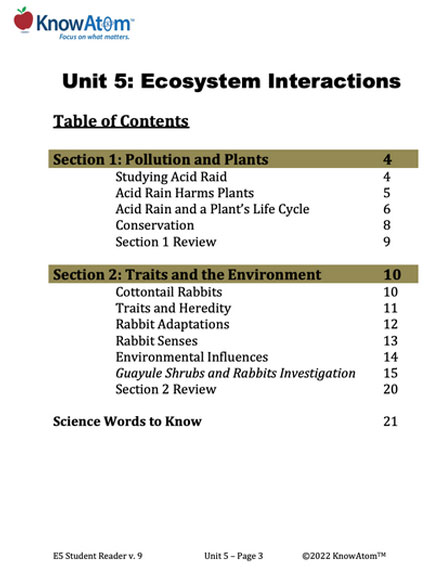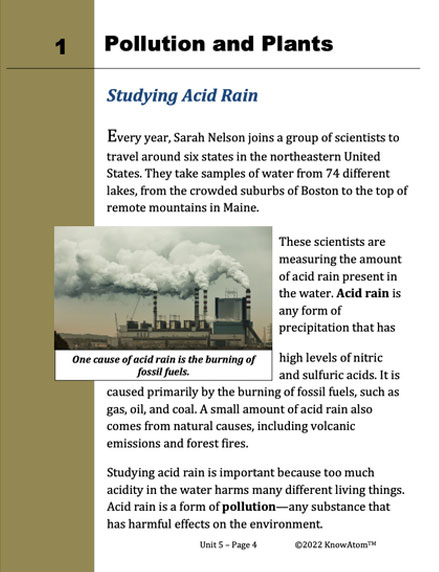In this lesson, students investigate how acid rain can disrupt a plant’s life cycle by damaging its external structures.
In this unit, students focus on how environmental changes impact the ability of organisms to survive, grow, and reproduce, passing their traits on to future generations. In this lesson, students continue their analysis of how a plant’s structures allow it to grow and develop, focusing on how a change in the environment such as pollution can impact a plant’s ability to complete its life cycle. Specifically, students investigate how acid rain affects the external structures of aquatic plants. This page provides an overview of this lesson.
The science background section provides teachers with more detailed information about the phenomena students explore in this unit. Below is an excerpt from the science background information on plant growth and acid rain.
In the mid-1800s, people started noticing a connection between the locations of large industrial areas and damaged forests, observing that forests downwind of industrial plants weren’t growing as well. This was the first time acid rain had been observed. Acid rain is any form of precipitation that has high levels of nitric and sulfuric acids. It is caused primarily by the burning of fossil fuels, such as gas, oil, and coal, although a small percentage comes from natural causes, including volcanic emissions and forest fires.
Despite being noticed in the 1800s, acid rain wasn’t considered a significant environmental threat until the 1970s, when scientists began noticing that some lakes and streams were becoming more acidic. Studying acid rain is important because too much acidity in the water harms many different living things. Acid rain is a form of pollution—any substance that has harmful effects on the environment.
Acid rain can also damage a plant’s leaves, causing them to look spotted or to drop earlier than normal. This causes the plant to become weak because leaves have most of the plant’s chloroplasts to collect sunlight and convert it into energy the plant can use to grow and develop through photosynthesis. When a plant’s leaves are damaged by acid rain, they can no longer photosynthesize as well.
Acid rain generally doesn’t kill plants directly. Instead, it damages their external structures, making it harder for them to grow and develop. For example, plants use their roots to anchor a plant in place and take nutrients and water from the soil. Scientists know that acidic water dissolves the nutrients and minerals in the soil and then washes them away before trees and other plants can use them to grow. Acid rain can also stunt root growth.
When the structures of a plant are damaged by acid rain, they are less able to complete their life cycle. A life cycle is the series of developmental stages an organism passes through on its way from birth to death. There is a pattern to the changes that all living things go through as they grow and develop. All life cycles include birth, growth, reproduction, and death.
The seed is the first step in a flowering plant’s life cycle. The seed protects the plant in a protective coat as it travels from its parent to a new location. With enough light and warmth from the sun, the seed will start to grow. During this step, the plant breaks out of its seed coat and begins to sprout, a process called germination. It grows roots, stems, and leaves. With leaves, it can capture energy from sunlight.
In the third step, the plant grows buds and flowers. Flowers are external structures where seeds form and pollination occurs. Flowers attract pollinators so the plant can make new seeds. Finally, the plant produces fruits that attract animals, or produce seed casings that allow the seed to travel by wind or water. The seeds grow and start the plant life cycle over again.
Acid rain can prevent a plant’s flowers from blooming or cause them to fall off the plant before they are pollinated. This affects a plant’s ability to reproduce. Reproduction is the ability of a mature organism to have offspring. Without reproduction, a group of organisms will die out. Because of this, reproduction is an essential step in the life cycles of all living things.
In this lesson, students investigate how acid rain can disrupt a plant’s life cycle by damaging its external structures.

Prepared hands-on materials, full year grade-specific curriculum, and personalized live professional development designed to support mastery of current state science standards.
Acid Rain : any form of precipitation that has high levels of nitric and sulfuric acids
Change : to make something different from what it is now
Life Cycle : the series of developmental stages an organism passes through on its way from birth to death
Pollution : any substance that has harmful effects on the environment
Reproduction : the ability of a mature organism to have offspring
Studying Acid Rain
Every year, Sarah Nelson joins a group of scientists to travel around six states in the northeastern United States. They take samples of water from 74 different lakes, from the crowded suburbs of Boston to the top of remote mountains in Maine.
Studying acid rain is important because too much acidity in the water harms many different living things. Acid rain is a form of pollution—any substance that has harmful effects on the environment.
These scientists are measuring the amount of acid rain present in the water. Acid rain is any form of precipitation that has high levels of nitric and sulfuric acids. It is caused primarily by the burning of fossil fuels, such as gas, oil, and coal. A small amount of acid rain also comes from natural causes, including volcanic emissions and forest fires.


Acid Rain Harms Plants
Acid rain generally doesn’t kill plants directly. Instead, it damages their external structures. This makes it harder for them to grow and develop.
For example, plants use their roots to anchor themselves in place and take nutrients and water from the soil. Scientists know that acidic water dissolves the nutrients and minerals in the soil and then washes them away before trees and other plants can use them to grow. Acid rain can also slow down or reduce root growth.
Acid rain can also damage a plant’s leaves. It can cause them to look spotted or to drop earlier than normal. This causes the plant to become weak because leaves have most of the plant’s chloroplasts. When a plant’s leaves are damaged by acid rain, they can no longer photosynthesize as well. Remember that leaves collect sunlight and convert it into energy the plant can use to grow and develop through photosynthesis.
Acid Rain and a Plant’s Life Cycle
When the structures of a plant are damaged by acid rain, they are less able to complete their life cycle. A life cycle is the series of developmental stages an organism passes through on its way from birth to death.
There is a pattern to the changes that all living things go through as they grow and develop. All life cycles include birth, growth, reproduction, and death. The seed is the first step in a flowering plant’s life cycle. The seed protects the plant in a protective coat as it travels from its parent to a new location.
With enough light and warmth from the sun, the seed will start to grow. During this step, the plant breaks out of its seed coat and begins to sprout. This is called germination. It grows roots, stems, and leaves. With leaves, it can capture energy from sunlight.

Students develop an experiment to figure out how much increasing levels of acid rain in water affects the external structures of aquatic plants. Students collect data over a a short period of time to analyze the connection between an environmental change and an organism’s ability to survive.
KnowAtom incorporates formative and summative assessments designed to make students thinking visible for deeper student-centered learning.

Standards citation: NGSS Lead States. 2013. Next Generation Science Standards: For States, By States. Washington, DC: The National Academies Press. Neither WestEd nor the lead states and partners that developed the Next Generation Science Standards were involved in the production of this product, and do not endorse it.
